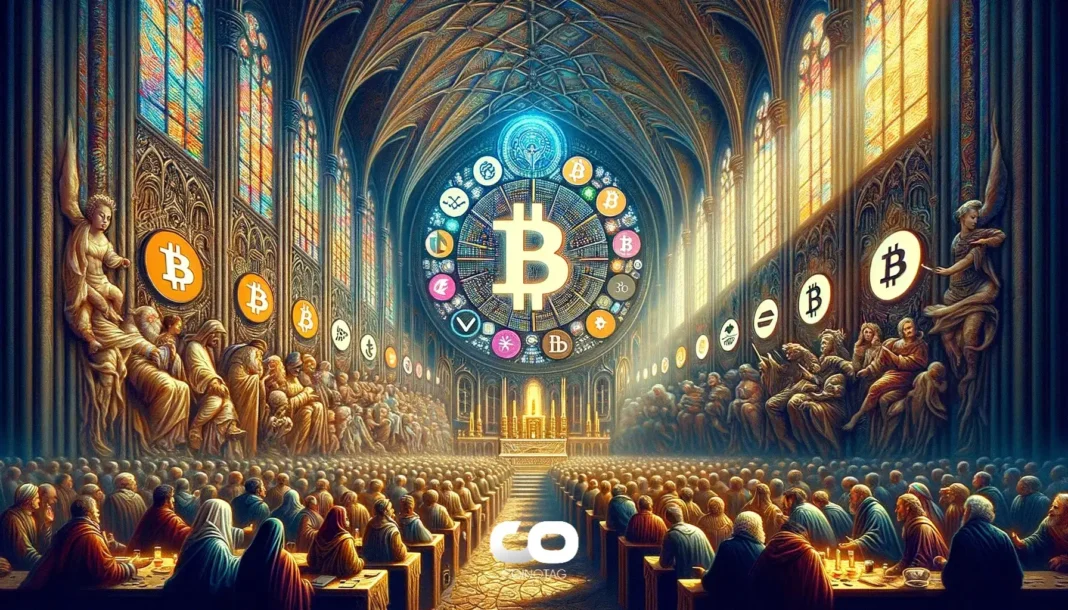| COINOTAG recommends • Exchange signup |
| 💹 Trade with pro tools |
| Fast execution, robust charts, clean risk controls. |
| 👉 Open account → |
| COINOTAG recommends • Exchange signup |
| 🚀 Smooth orders, clear control |
| Advanced order types and market depth in one view. |
| 👉 Create account → |
| COINOTAG recommends • Exchange signup |
| 📈 Clarity in volatile markets |
| Plan entries & exits, manage positions with discipline. |
| 👉 Sign up → |
| COINOTAG recommends • Exchange signup |
| ⚡ Speed, depth, reliability |
| Execute confidently when timing matters. |
| 👉 Open account → |
| COINOTAG recommends • Exchange signup |
| 🧭 A focused workflow for traders |
| Alerts, watchlists, and a repeatable process. |
| 👉 Get started → |
| COINOTAG recommends • Exchange signup |
| ✅ Data‑driven decisions |
| Focus on process—not noise. |
| 👉 Sign up → |
Ethereum Layer 2 solutions maintain robust security against 51% attacks on the main chain, as they inherit Layer 1’s finality guarantees. Vitalik Buterin explains that even if over 51% of validators collude, invalid blocks cannot validate, protecting user assets unless validators explicitly side with attackers. This design ensures funds in L2 ecosystems like Arbitrum and Optimism remain safe.
-
Ethereum’s core property prevents 51% attacks from making invalid transactions valid, safeguarding L2 funds directly tied to Layer 1 security.
-
Layer 2 networks such as Arbitrum, Base, Optimism, and Worldchain collectively lock over $35 billion in value, relying on Ethereum’s proven security model.
-
Solana’s co-founder Anatoly Yakovenko proposes a new bridge treating Ethereum as an L2 for Solana, potentially challenging Ethereum’s dominance while addressing security concerns.
Discover how Ethereum L2 security withstands 51% attacks, with insights from Vitalik Buterin. Explore Solana’s bridge proposal and implications for crypto assets. Stay informed on blockchain safety—read now for expert analysis.
What Makes Ethereum L2 Security Resilient to 51% Attacks?
Ethereum L2 security is fundamentally tied to the Layer 1 blockchain’s integrity, ensuring that even a 51% attack cannot compromise user funds in Layer 2 ecosystems. Vitalik Buterin, Ethereum’s co-founder, has emphasized that a core blockchain principle prevents invalid blocks from becoming valid, regardless of validator collusion or software issues. This protection extends to L2s because they settle transactions on Ethereum’s main chain, maintaining asset safety unless validators deliberately operate outside the network’s rules.
| COINOTAG recommends • Professional traders group |
| 💎 Join a professional trading community |
| Work with senior traders, research‑backed setups, and risk‑first frameworks. |
| 👉 Join the group → |
| COINOTAG recommends • Professional traders group |
| 📊 Transparent performance, real process |
| Spot strategies with documented months of triple‑digit runs during strong trends; futures plans use defined R:R and sizing. |
| 👉 Get access → |
| COINOTAG recommends • Professional traders group |
| 🧭 Research → Plan → Execute |
| Daily levels, watchlists, and post‑trade reviews to build consistency. |
| 👉 Join now → |
| COINOTAG recommends • Professional traders group |
| 🛡️ Risk comes first |
| Sizing methods, invalidation rules, and R‑multiples baked into every plan. |
| 👉 Start today → |
| COINOTAG recommends • Professional traders group |
| 🧠 Learn the “why” behind each trade |
| Live breakdowns, playbooks, and framework‑first education. |
| 👉 Join the group → |
| COINOTAG recommends • Professional traders group |
| 🚀 Insider • APEX • INNER CIRCLE |
| Choose the depth you need—tools, coaching, and member rooms. |
| 👉 Explore tiers → |
Buterin’s insights highlight how Ethereum’s proof-of-stake mechanism adds layers of resilience, making it difficult for attackers to rewrite history without broad consensus. As a result, popular L2 platforms continue to thrive, hosting billions in total value locked without fear of sudden asset theft from main chain vulnerabilities.
How Does Solana’s Bridge Proposal Impact Ethereum L2 Design?
Solana co-founder Anatoly Yakovenko recently suggested developing a specialized bridge that positions Ethereum as a Layer 2 for Solana, aiming to facilitate seamless asset transfers between the two ecosystems. This proposal arises amid discussions on blockchain interoperability, where both networks operate as Layer 1s but could benefit from enhanced connectivity. Yakovenko noted that such a bridge could mitigate risks like delays from attacks, without directly relying on Ethereum’s security for Solana’s core operations.
| COINOTAG recommends • Exchange signup |
| 📈 Clear interface, precise orders |
| Sharp entries & exits with actionable alerts. |
| 👉 Create free account → |
| COINOTAG recommends • Exchange signup |
| 🧠 Smarter tools. Better decisions. |
| Depth analytics and risk features in one view. |
| 👉 Sign up → |
| COINOTAG recommends • Exchange signup |
| 🎯 Take control of entries & exits |
| Set alerts, define stops, execute consistently. |
| 👉 Open account → |
| COINOTAG recommends • Exchange signup |
| 🛠️ From idea to execution |
| Turn setups into plans with practical order types. |
| 👉 Join now → |
| COINOTAG recommends • Exchange signup |
| 📋 Trade your plan |
| Watchlists and routing that support focus. |
| 👉 Get started → |
| COINOTAG recommends • Exchange signup |
| 📊 Precision without the noise |
| Data‑first workflows for active traders. |
| 👉 Sign up → |
Currently, Ethereum’s L2s, including Arbitrum with its optimistic rollups and Optimism’s focus on scalability, hold substantial value—over $35 billion across major platforms as reported by industry data trackers. This locked value underscores Ethereum’s market leadership in scaling solutions. In contrast, treating Ethereum as an L2 for Solana could introduce new dynamics, potentially allowing Solana users to access Ethereum’s liquidity while bypassing some settlement dependencies. However, experts caution that true security for bridged assets would still hinge on the underlying protocols’ robustness.
Buterin’s response indirectly reinforces Ethereum’s advantages, pointing out that L2 funds derive safety from Layer 1’s unalterable finality. Data from blockchain analytics shows Ethereum’s validator set exceeding 1 million active participants, far outpacing Solana’s around 2,000, which bolsters resistance to coordinated attacks. Yakovenko’s idea, while innovative, sparks debate on whether it challenges Ethereum’s L2 dominance or simply expands multi-chain possibilities.
| COINOTAG recommends • Traders club |
| ⚡ Futures with discipline |
| Defined R:R, pre‑set invalidation, execution checklists. |
| 👉 Join the club → |
| COINOTAG recommends • Traders club |
| 🎯 Spot strategies that compound |
| Momentum & accumulation frameworks managed with clear risk. |
| 👉 Get access → |
| COINOTAG recommends • Traders club |
| 🏛️ APEX tier for serious traders |
| Deep dives, analyst Q&A, and accountability sprints. |
| 👉 Explore APEX → |
| COINOTAG recommends • Traders club |
| 📈 Real‑time market structure |
| Key levels, liquidity zones, and actionable context. |
| 👉 Join now → |
| COINOTAG recommends • Traders club |
| 🔔 Smart alerts, not noise |
| Context‑rich notifications tied to plans and risk—never hype. |
| 👉 Get access → |
| COINOTAG recommends • Traders club |
| 🤝 Peer review & coaching |
| Hands‑on feedback that sharpens execution and risk control. |
| 👉 Join the club → |
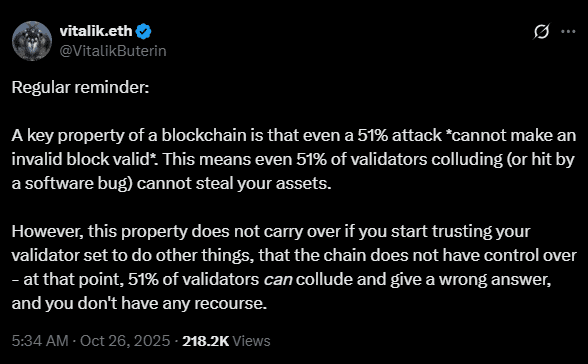
Source: X
Further, Buterin advocates for automated countermeasures against potential 51% threats. In prior discussions, he proposed software that detects censorship or attacks and automatically restores main chain integrity, ensuring validators respond swiftly without manual intervention. This vision aligns with Ethereum’s ongoing upgrades, like the Dencun hard fork, which enhance L2 efficiency and security.
Yakovenko’s comments suggest openness to market-driven adoption: if demand exceeds existing bridges like Wormhole, the Ethereum-as-L2 model could gain traction. Yet, Ethereum proponents argue that superior user experience, lower costs, and battle-tested security will maintain its edge. Recent performance metrics indicate Solana outperforming Ethereum by 30% in August but lagging by 10% since late September, per TradingView ratios, reflecting shifting market sentiments.
| COINOTAG recommends • Exchange signup |
| 📈 Clear control for futures |
| Sizing, stops, and scenario planning tools. |
| 👉 Open futures account → |
| COINOTAG recommends • Exchange signup |
| 🧩 Structure your futures trades |
| Define entries & exits with advanced orders. |
| 👉 Sign up → |
| COINOTAG recommends • Exchange signup |
| 🛡️ Control volatility |
| Automate alerts and manage positions with discipline. |
| 👉 Get started → |
| COINOTAG recommends • Exchange signup |
| ⚙️ Execution you can rely on |
| Fast routing and meaningful depth insights. |
| 👉 Create account → |
| COINOTAG recommends • Exchange signup |
| 📒 Plan. Execute. Review. |
| Frameworks for consistent decision‑making. |
| 👉 Join now → |
| COINOTAG recommends • Exchange signup |
| 🧩 Choose clarity over complexity |
| Actionable, pro‑grade tools—no fluff. |
| 👉 Open account → |
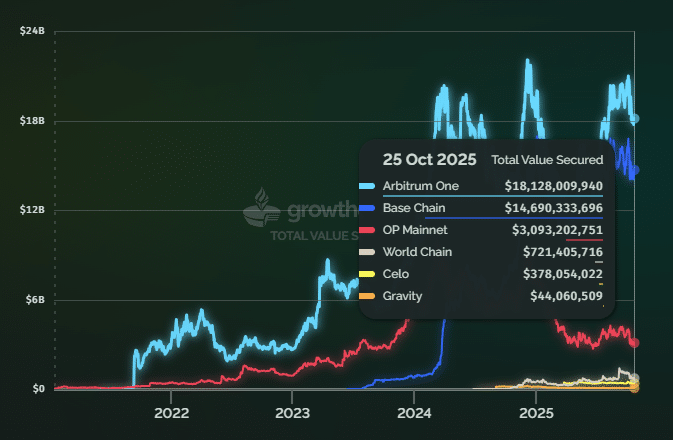
Source: GrowthThePie
| COINOTAG recommends • Members‑only research |
| 📌 Curated setups, clearly explained |
| Entry, invalidation, targets, and R:R defined before execution. |
| 👉 Get access → |
| COINOTAG recommends • Members‑only research |
| 🧠 Data‑led decision making |
| Technical + flow + context synthesized into actionable plans. |
| 👉 Join now → |
| COINOTAG recommends • Members‑only research |
| 🧱 Consistency over hype |
| Repeatable rules, realistic expectations, and a calmer mindset. |
| 👉 Get access → |
| COINOTAG recommends • Members‑only research |
| 🕒 Patience is an edge |
| Wait for confirmation and manage risk with checklists. |
| 👉 Join now → |
| COINOTAG recommends • Members‑only research |
| 💼 Professional mentorship |
| Guidance from seasoned traders and structured feedback loops. |
| 👉 Get access → |
| COINOTAG recommends • Members‑only research |
| 🧮 Track • Review • Improve |
| Documented PnL tracking and post‑mortems to accelerate learning. |
| 👉 Join now → |
Community reactions vary, with some users emphasizing that Ethereum L2s prioritize practical benefits like faster transactions and reduced fees over speculative bridging innovations. As blockchain ecosystems evolve, these discussions underscore the importance of hybrid approaches to security and scalability.
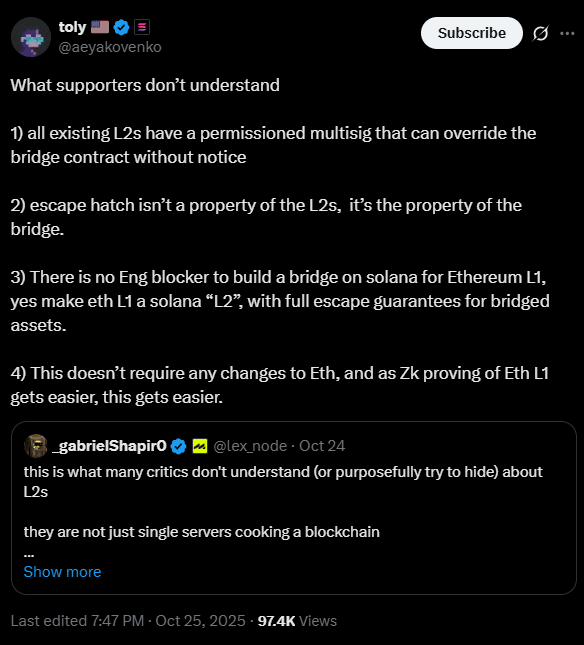
| COINOTAG recommends • Exchange signup |
| 🎯 Focus on process over noise |
| Plan trades, size positions, execute consistently. |
| 👉 Sign up → |
| COINOTAG recommends • Exchange signup |
| 🛠️ Simplify execution |
| Keep decisions clear with practical controls. |
| 👉 Get started → |
| COINOTAG recommends • Exchange signup |
| 📊 Make data your edge |
| Use depth and alerts to avoid guesswork. |
| 👉 Open account → |
| COINOTAG recommends • Exchange signup |
| 🧭 Be prepared, not reactive |
| Turn setups into rules before you trade. |
| 👉 Create account → |
| COINOTAG recommends • Exchange signup |
| ✍️ Plan first, then act |
| Entries, exits, and reviews that fit your routine. |
| 👉 Join now → |
| COINOTAG recommends • Exchange signup |
| 🧩 Consistency beats intensity |
| Small, repeatable steps win the long run. |
| 👉 Sign up → |
Source: X
Frequently Asked Questions
What Happens to Ethereum L2 Funds During a 51% Attack?
In a 51% attack scenario, Ethereum L2 funds remain protected because Layer 2 solutions settle on the secure Layer 1 chain, where invalid blocks cannot be validated. Vitalik Buterin confirms that user assets are safe unless validators collude beyond the network’s rules. This design has proven resilient in simulations and real-world stress tests, with over $35 billion in L2 value locked securely.
| COINOTAG recommends • Premium trading community |
| 🏛️ WAGMI CAPITAL — Premium Trading Community |
| Strategic insights, exclusive opportunities, professional support. |
| 👉 Join WAGMI CAPITAL → |
| COINOTAG recommends • Premium trading community |
| 💬 Inner Circle access |
| See members share real‑time PnL and execution notes in chat. |
| 👉 Apply for Inner Circle → |
| COINOTAG recommends • Premium trading community |
| 🧩 Turn theses into trades |
| Reusable templates for entries, risk, and review—end to end. |
| 👉 Join the club → |
| COINOTAG recommends • Premium trading community |
| 💡 Long‑term mindset |
| Patience and discipline over noise; a process that compounds. |
| 👉 Get started → |
| COINOTAG recommends • Premium trading community |
| 📚 Education + execution |
| Courses, playbooks, and live market walkthroughs—learn by doing. |
| 👉 Get access → |
| COINOTAG recommends • Premium trading community |
| 🔒 Members‑only research drops |
| Curated analyses and private briefings—quality over quantity. |
| 👉 Join WAGMI CAPITAL → |
Why Is Solana Considering Ethereum as an L2 for Bridging?
Solana’s co-founder Anatoly Yakovenko proposes bridging Solana to Ethereum as an L2 to enable efficient asset transfers and leverage Ethereum’s liquidity without full settlement dependencies. This could delay chain operations during attacks but protect bridged assets. If user demand grows beyond tools like Wormhole, it might expand interoperability, though Ethereum’s native L2s already dominate with superior security and scalability.
Key Takeaways
- Ethereum’s Blockchain Integrity: A 51% attack cannot validate invalid blocks, ensuring L2 user assets stay protected by inheriting Layer 1 security.
- Solana’s Innovative Bridge: Anatoly Yakovenko’s proposal treats Ethereum as an L2 for Solana, potentially challenging market shares while focusing on seamless connectivity.
- Future Automation: Vitalik Buterin’s vision includes automated responses to attacks, enhancing validator efficiency and long-term network resilience.
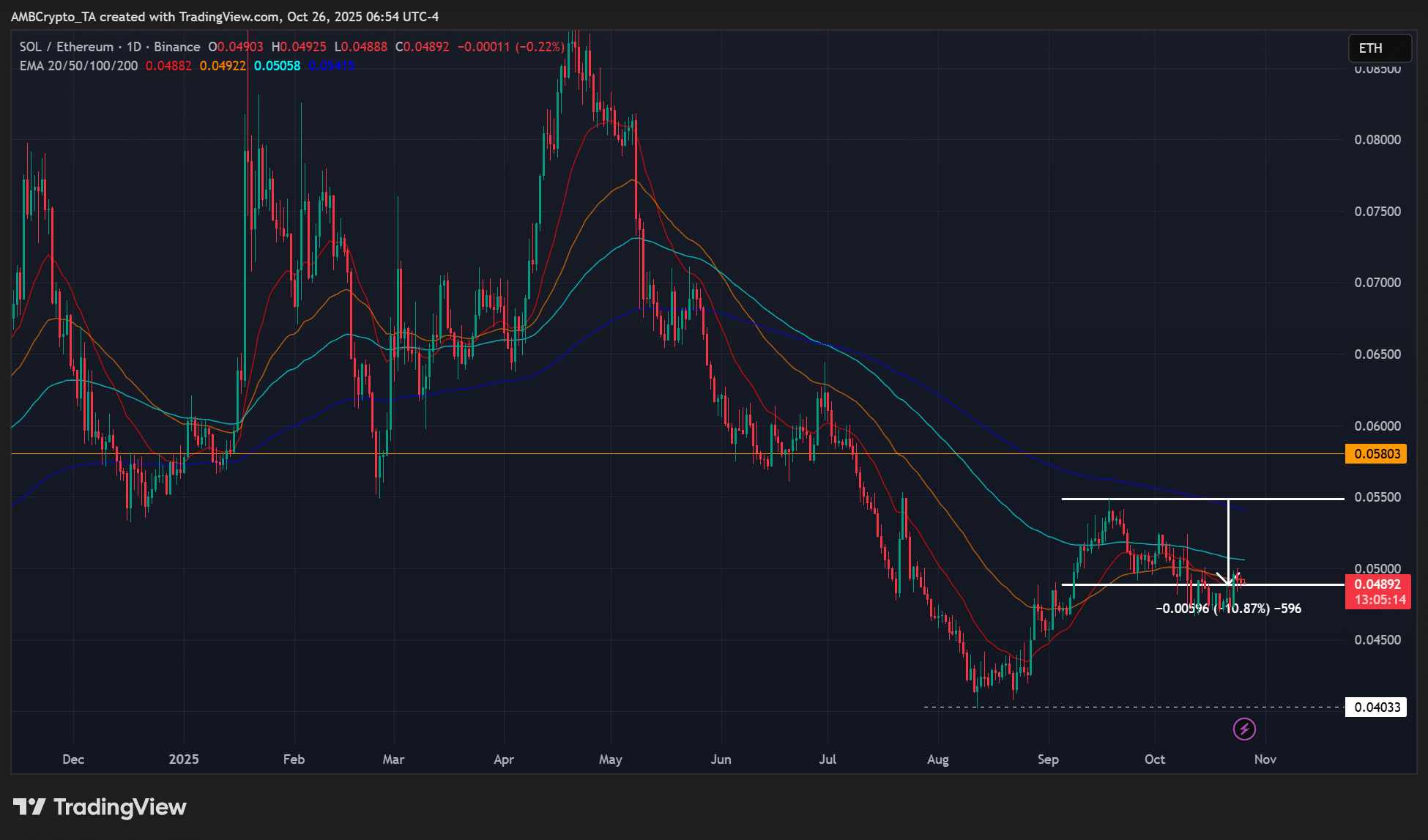
| COINOTAG recommends • Exchange signup |
| 🧱 Execute with discipline |
| Watchlists, alerts, and flexible order control. |
| 👉 Sign up → |
| COINOTAG recommends • Exchange signup |
| 🧩 Keep your strategy simple |
| Clear rules and repeatable steps. |
| 👉 Open account → |
| COINOTAG recommends • Exchange signup |
| 🧠 Stay objective |
| Let data—not emotion—drive actions. |
| 👉 Get started → |
| COINOTAG recommends • Exchange signup |
| ⏱️ Trade when it makes sense |
| Your plan sets the timing—not the feed. |
| 👉 Join now → |
| COINOTAG recommends • Exchange signup |
| 🌿 A calm plan for busy markets |
| Set size and stops first, then execute. |
| 👉 Create account → |
| COINOTAG recommends • Exchange signup |
| 🧱 Your framework. Your rules. |
| Design entries/exits that fit your routine. |
| 👉 Sign up → |
Source: SOL/ETH ratio, TradingView
Conclusion
Ethereum L2 security stands as a cornerstone of blockchain innovation, with Vitalik Buterin’s explanations clarifying its resistance to 51% attacks and Solana’s bridge proposal adding new interoperability layers. As networks like Arbitrum and Optimism secure billions in value, these developments signal a maturing crypto landscape focused on safety and efficiency. Looking ahead, automated defenses and cross-chain bridges could further solidify Ethereum’s position, encouraging users to explore secure scaling solutions for the evolving digital economy.
| COINOTAG recommends • Members‑only research |
| 📌 Curated setups, clearly explained |
| Entry, invalidation, targets, and R:R defined before execution. |
| 👉 Get access → |
| COINOTAG recommends • Members‑only research |
| 🧠 Data‑led decision making |
| Technical + flow + context synthesized into actionable plans. |
| 👉 Join now → |
| COINOTAG recommends • Members‑only research |
| 🧱 Consistency over hype |
| Repeatable rules, realistic expectations, and a calmer mindset. |
| 👉 Get access → |
| COINOTAG recommends • Members‑only research |
| 🕒 Patience is an edge |
| Wait for confirmation and manage risk with checklists. |
| 👉 Join now → |
| COINOTAG recommends • Members‑only research |
| 💼 Professional mentorship |
| Guidance from seasoned traders and structured feedback loops. |
| 👉 Get access → |
| COINOTAG recommends • Members‑only research |
| 🧮 Track • Review • Improve |
| Documented PnL tracking and post‑mortems to accelerate learning. |
| 👉 Join now → |





